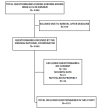Difference in Sun Exposure Habits Between Individuals with High and Low Risk of Skin Cancer
- PMID: 34631260
- PMCID: PMC8480439
- DOI: 10.5826/dpc.1104a90
Difference in Sun Exposure Habits Between Individuals with High and Low Risk of Skin Cancer
Abstract
Background: Skin cancer incidence is rapidly increasing. The main risk factor, sun exposure, can be modified. Informational campaigns can be effective in raising skin cancer awareness and target the high-risk population. Still, sun exposure habits in people at high risk of skin cancer are not well-known.
Objective: To investigate if and how sun exposure habits differ between low-risk and high-risk individuals.
Methods: During the Swedish Euromelanoma campaign of 2018, questionnaires were collected containing information regarding sun exposure habits and risk factors for skin cancer. Data on 4,141 participants was used to investigate the association between risk factors and sun exposure habits.
Results: A fair skin type and a previous history of skin cancer were significantly associated with enhanced sun protective behavior. Family history of skin cancer, childhood sunburns and the presence of large/atypical nevi had no effect on sun exposure habits. Going on sunny holidays were particularly unaffected by being at high risk of skin cancer.
Conclusion: Individuals at high risk of developing skin cancer showed suboptimal sun exposure habits and harmful traveling behaviors. We suggest that future skin cancer campaigns inform on accurate sun protection behavior during sunny holidays and associated risk factors. Risk factors such as childhood sunburns, numerous common and large/atypical nevi, as well as family history of skin cancer seem to be less recognized by the population.
Keywords: melanoma; risk factors; skin cancer; sun habits.
©2021 Karlsson et al.
Conflict of interest statement
Competing interests: The Euromelanoma campaign is funded by sponsorship and part of the funding is used for data input and statistical analyses. Oskar Karlsson and Oskar Hagberg were engaged by the campaign to perform these tasks. The sponsors had no impact on the preparation, results, or publication of the study.
Figures
Similar articles
-
Do Athletes Practicing Outdoors Know and Care Enough About the Importance of Photoprotection?Acta Dermatovenerol Croat. 2020 Jul;28(1):41-42. Acta Dermatovenerol Croat. 2020. PMID: 32650851
-
Prevalence of common and atypical melanocytic nevi in young adults and its relationship with sun protection and exposure habits.Eur J Dermatol. 2015 Jan-Feb;25(1):45-51. doi: 10.1684/ejd.2014.2482. Eur J Dermatol. 2015. PMID: 25547029
-
The influence of painful sunburns and lifetime sun exposure on the risk of actinic keratoses, seborrheic warts, melanocytic nevi, atypical nevi, and skin cancer.J Invest Dermatol. 2003 Jun;120(6):1087-93. doi: 10.1046/j.1523-1747.2003.12246.x. J Invest Dermatol. 2003. PMID: 12787139
-
Acute skin sun damage in children and its consequences in adults.Coll Antropol. 2010 Apr;34 Suppl 2:233-7. Coll Antropol. 2010. PMID: 21302727 Review.
-
Summer sun-exposure in Australian childhood cancer survivors and community reference groups.Semin Oncol. 2020 Feb;47(1):48-55. doi: 10.1053/j.seminoncol.2020.02.004. Epub 2020 Feb 22. Semin Oncol. 2020. PMID: 32145971 Review.
Cited by
-
Factors for not performing total body skin examinations in primary care in association with teledermoscopy.BMC Prim Care. 2023 Mar 21;24(1):76. doi: 10.1186/s12875-023-02034-4. BMC Prim Care. 2023. PMID: 36944927 Free PMC article.
-
Behaviour and sun exposure in holidaymakers alters skin microbiota composition and diversity.Front Aging. 2023 Aug 8;4:1217635. doi: 10.3389/fragi.2023.1217635. eCollection 2023. Front Aging. 2023. PMID: 37614517 Free PMC article.
-
Educational level-dependent melanoma awareness in a high-risk population in Switzerland.Front Oncol. 2023 May 3;13:1174542. doi: 10.3389/fonc.2023.1174542. eCollection 2023. Front Oncol. 2023. PMID: 37207151 Free PMC article.
-
Quality of Life and the Role of Gender in Patients With Non-Melanoma Skin Cancer in Greece.Cureus. 2025 Jan 9;17(1):e77195. doi: 10.7759/cureus.77195. eCollection 2025 Jan. Cureus. 2025. PMID: 39925568 Free PMC article.
References
-
- Torre LA, Siegel RL, Ward EM, Jemal A, et al. Global Cancer Incidence and Mortality Rates and Trends--An Update. Cancer epidemiology, biomarkers & prevention : a publication of the American Association for Cancer Research, cosponsored by the American Society of Preventive Oncology. 2016;25(1):16–27. doi: 10.1158/1055-9965.EPI-15-0578. - DOI - PubMed
-
- Swedish Cancer Registry. 2018. [Accessed 5 May, 2020]. Available from: https://sdb.socialstyrelsen.se/if_can/val.aspx.
LinkOut - more resources
Full Text Sources

